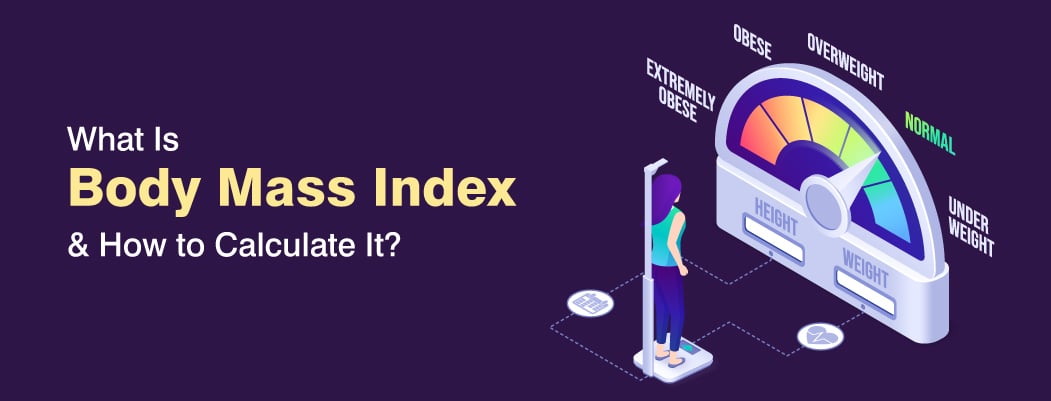How to Find BMI?
February 19, 2025

Body Mass Index (BMI) is a widely used measurement to assess an individual’s body weight in relation to their height. Understanding BMI is important as it provides insights into weight status and potential health risks associated with it. In this blog, we will explore the concept of BMI, how to calculate it, its significance in diagnosing weight types, and its role as a screening tool for health risks. By the end, you will comprehensively understand BMI and its implications for overall well-being.
Body Mass Index (BMI) is a numerical value derived from a height and weight measurement formula. It provides a general assessment of an individual’s body weight in relation to their height. BMI categorizes individuals into weight classes and provides a starting point for evaluating weight status and potential health risks.
BMI Chart
The BMI chart visually represents BMI values categorized into different weight types. It serves as a reference tool to determine an individual’s weight status. The chart typically includes ranges for underweight, normal weight, overweight, and obese categories. By locating their BMI value on the chart, individuals can quickly identify their weight category.
What is BMI Used for?
BMI is used as a screening tool to assess weight status and identify potential health risks. Healthcare professionals commonly utilise BMI to evaluate the risk of developing obesity-related conditions, such as cardiovascular diseases, diabetes, and certain types of cancer. BMI serves as an initial indicator, prompting further evaluation and discussion about lifestyle changes, dietary modifications, and additional health screenings.
Diagnosing Weight Types with BMI
BMI allows for the diagnosis of weight types based on the BMI chart. The chart provides clear distinctions between underweight, normal weight, overweight, and obese categories. Each weight type has its own characteristics and potential health implications. By understanding the weight types associated with BMI ranges, individuals can gain insights into the potential health risks associated with their weight category.
Formula
The BMI formula calculates BMI using height and weight measurements. The formula is as follows:
BMI = weight (kg) / height (m^2)
To calculate BMI, measure your weight in kilograms(kg) and your height in meters(m). Square your height measurement and divide your weight by the squared height value. The resulting number is your BMI.
Normal BMI
A normal BMI falls within the range considered healthy and indicates a balanced weight. The World Health Organization (WHO) defines the following BMI ranges:
- Underweight: BMI less than 18.5
- Normal weight: BMI between 18.5 and 24.9
- Overweight: BMI between 25 and 29.9
- Obesity: BMI of 30 or higher, further categorized into Class I (BMI 30-34.9), Class II (BMI 35-39.9), and Class III (BMI 40 or higher)
It’s important to note that BMI is a general indicator and does not take into account factors such as muscle mass or body composition. Therefore, it’s always beneficial to consult a healthcare professional for a comprehensive evaluation.
Screening for Health Risks with BMI
BMI serves as a screening tool for potential health risks associated with weight. Higher BMI values are often correlated with an increased risk of developing various health conditions. However, it’s crucial to understand that BMI is not a diagnostic tool and does not account for individual variations. Further assessments, such as body composition analysis, blood tests, and discussions with healthcare professionals, are essential to evaluate health risks and determine appropriate interventions accurately.
Limitations of Calculating BMI
While BMI is widely used to assess body weight categories, it has several limitations that make it an imperfect tool for measuring health and body composition.
1. Does Not Differentiate Between Muscle and Fat
BMI measures weight in relation to height but does not distinguish between muscle and fat. Consequently, individuals with high muscle mass, like athletes, may be misclassified as overweight or obese despite having low body fat.
2. Ignores Fat Distribution
The way body fat is distributed significantly impacts health risks. Excess fat around the abdomen is linked to higher risks of conditions like heart disease and diabetes, but BMI does not account for where fat is stored in the body.
3. Not Suitable for Certain Populations
BMI calculations may not be accurate for:
- Pregnant women
- Children and teenagers (who have different growth patterns)
- Muscle mass naturally declines as people age, especially in older adults.
- People with medical conditions affecting fluid retention or body composition
4. Does Not Consider Age or Sex Differences
Men and women have different body compositions, with women naturally having a higher percentage of body fat. Similarly, BMI does not adjust for age-related changes in muscle and fat distribution.
5. Limited Use as a Health Risk Indicator
Although BMI is commonly associated with health risks, it overlooks factors such as lifestyle, genetics, and key health indicators like cholesterol levels and blood pressure, which offer a more comprehensive view of overall health.
A More Holistic Approach
To better assess health risks, BMI should be used alongside other measurements such as waist circumference, body fat percentage, and overall lifestyle factors. This combined approach offers a clearer understanding of an individual’s health status.
Summary
Body Mass Index (BMI) is useful for assessing weight status and potential health risks associated with weight. By understanding BMI and its applications, individuals can gain insights into their weight category and potential health implications. However, it’s important to remember that BMI is just one piece of the puzzle. Consulting healthcare professionals, considering individual circumstances, and adopting a holistic approach to health and well-being are crucial for making informed decisions and maintaining optimal health.
Who to Consult?
If you have concerns regarding your BMI and wish to understand its implications better, it is advisable to consult specific specialists. These specialists include your primary care physician, a registered dietitian/nutritionist, an endocrinologist, or a bariatric specialist. These professionals can provide valuable insights and guidance based on their expertise. Your primary care physician can assess your overall health and discuss your BMI concerns, while a registered dietitian/nutritionist can offer personalized advice on nutrition and weight management. An endocrinologist specializes in hormonal disorders that may impact your weight, and a bariatric specialist can provide insights into advanced weight management options. Consulting with these specialists can help you navigate the complexities of BMI and receive tailored recommendations based on your individual circumstances.







